
Daucus carota, whose common names include wild carrot, European wild carrot, bird's nest, bishop's lace, and Queen Anne's lace, is a flowering plant in the family Apiaceae. It is native to temperate regions of the Old World and was naturalized in the New World.

The parsnip is a root vegetable closely related to carrot and parsley, all belonging to the flowering plant family Apiaceae. It is a biennial plant usually grown as an annual. Its long taproot has cream-colored skin and flesh, and, left in the ground to mature, it becomes sweeter in flavor after winter frosts. In its first growing season, the plant has a rosette of pinnate, mid-green leaves. If unharvested, it produces a flowering stem topped by an umbel of small yellow flowers in its second growing season, later producing pale brown, flat, winged seeds. By this time, the stem has become woody, and the tap root inedible.
Hardiness of plants describes their ability to survive adverse growing conditions. It is usually limited to discussions of climatic adversity. Thus a plant's ability to tolerate cold, heat, drought, flooding, or wind are typically considered measurements of hardiness. Hardiness of plants is defined by their native extent's geographic location: longitude, latitude and elevation. These attributes are often simplified to a hardiness zone. In temperate latitudes, the term most often describes resistance to cold, or "cold-hardiness", and is generally measured by the lowest temperature a plant can withstand.

Cicuta maculata is a highly poisonous species of flowering plant in the carrot family known by several common names, including spotted water hemlock, spotted parsley, spotted cowbane, and the suicide root by the Iroquois. It is native to nearly all of North America, from northern Canada to southern Mexico.

Carrot juice is juice produced from carrots.

The carrot is a root vegetable, typically orange in color, though purple, black, red, white, and yellow cultivars exist, all of which are domesticated forms of the wild carrot, Daucus carota, native to Europe and Southwestern Asia. The plant probably originated in Persia and was originally cultivated for its leaves and seeds. The most commonly eaten part of the plant is the taproot, although the stems and leaves are also eaten. The domestic carrot has been selectively bred for its enlarged, more palatable, less woody-textured taproot.

Daucus pusillus is a species of wild carrot known by the common names American wild carrot and rattle-snake-weed. Its Latin name means "little carrot", or "tiny carrot". It is similar in appearance to other species and subspecies of wild carrot, with umbels of white or pinkish flowers.
The monotypic genus Yabea contains the single species Yabea microcarpa, which is known by the common names California hedge parsley and false carrot. It is similar in appearance to other species of wild carrot and relatives. It is native to western North America, including the western United States, British Columbia and Baja California. It grows in many types of habitat.

Daucus glochidiatus, commonly known as Australian carrot, Austral carrot or native carrot, is a species of herb in the flowering plant family Apiaceae. It is native to Australia and New Zealand.
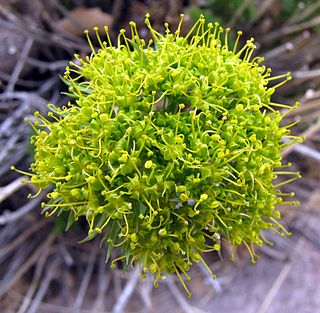
Lomatium parryi, commonly known as Parry's biscuitroot and Utah desertparsley, is a perennial herb in the carrot family. It is a common herb in high altitude areas of deserts and common in desert National parks, such as Death Valley mountains, in the western part of the United States.

Osmorhiza depauperata is a species of flowering plant in the carrot family known by the common names bluntseed sweetroot and blunt-fruited sweet-cicely.
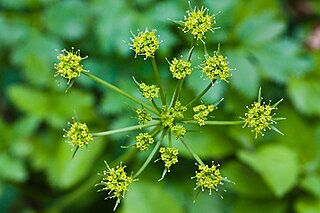
Tauschia hartwegii is a species of flowering plant in the carrot family known by the common name Hartweg's umbrellawort. It is endemic to California, where it is known from the Sierra Nevada foothills and some of the Central Coast Ranges. Its habitat includes coniferous woodlands and chaparral. It is a perennial herb growing 30 centimeters to one meter tall. It is coated in short, rough hairs. The leaves have blades which are divided into oval leaflets with serrated edges and borne on long petioles. The inflorescence is a compound umbel of yellow flowers with up to 30 unequal rays measuring 2 to 12 centimeters long each. The fruit is somewhat rounded in shape, ribbed, and under a centimeter long.
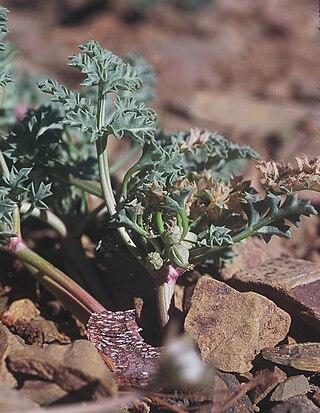
Tauschia howellii is a rare species of flowering plant in the carrot family known by the common names Howell's umbrellawort and Howell's tauschia. It is endemic to the Klamath Mountains of far southern Oregon and far northern California, where it is limited to nine occurrences in the Siskiyou Mountains. It grows in mountain forests on gravelly granite soils, often among stands of Shasta red fir. Despite its rarity it is stable and not considered very endangered. It is a perennial herb growing 30 to 80 centimeters tall. It is hairless in texture. The thick leaves have blades which are divided into leaflets large, sharp teeth and edges curved up, and borne on long petioles. The short inflorescence is a compound umbel of yellow flowers on a few short rays. The fruit is oblong, ribbed, and just a few millimeters long.
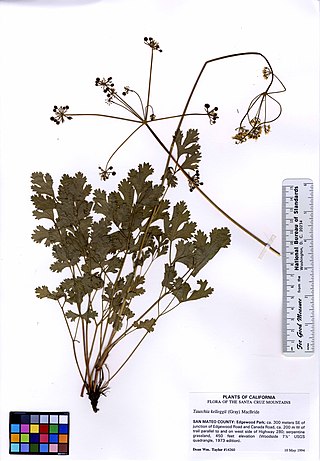
Tauschia kelloggii is a species of flowering plant in the carrot family known by the common name Kellogg's umbrellawort. It is native to the mountains of Oregon and the northern half of California, where it grows in chaparral, woodlands, forest, and other types of habitat. It is a perennial herb growing up to 70 centimeters tall. The leaves have blades which are divided into toothed or serrated leaflets, and sometimes subdivided further. The inflorescence is a compound umbel of yellow flowers with 10 to 20 rays measuring 2 to 12 centimeters long each. The fruit is somewhat rounded in shape, ribbed, and up to half a centimeter long.
Tauschia parishii is a species of flowering plant in the carrot family known by the common name Parish's umbrellawort. It is endemic to California.
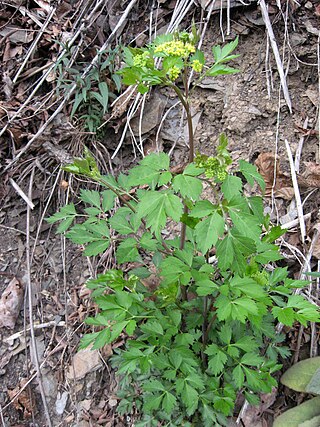
Thaspium is a genus of flowering plants in the Apiaceae. A common name for the various Thaspium species is meadowparsnip or meadow-parsip. Its native range is eastern North America, from eastern Texas in the southwest to Maine in the northeast.
Ignaz Friedrich Tausch was a Bohemian botanist.

Turgenia is a genus of flowering plants in the family Apiaceae, containing up to seven species. The genus resembles Caucalis. False carrot is a common name for plants in this genus.
Mildred Esther Mathias was an American botanist and professor.














